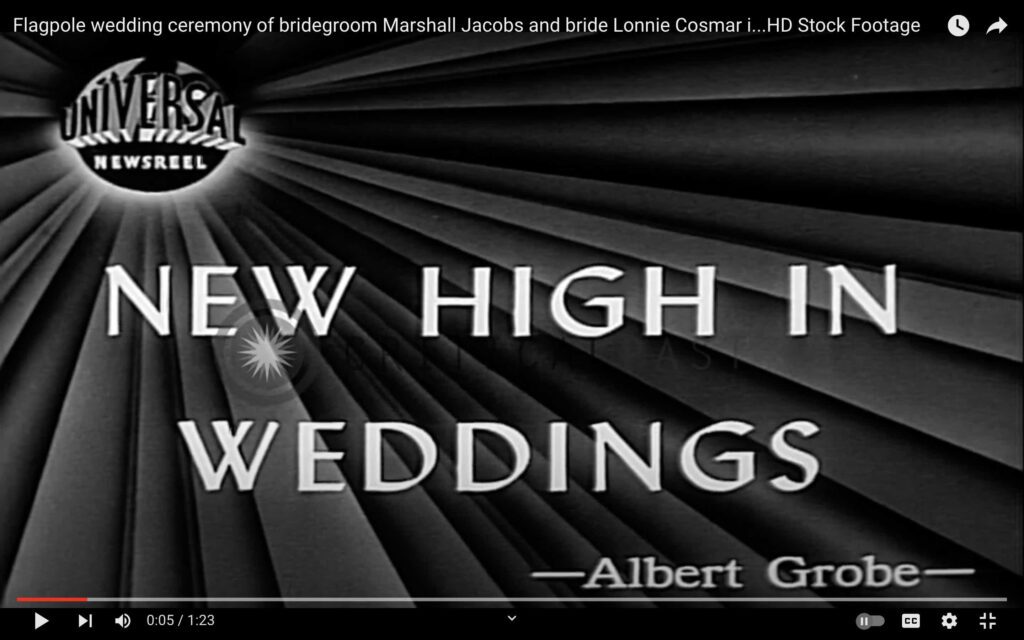A Unique Love Story
Allan Grant’s photograph, “Flagpole Wedding,” captures an extraordinary moment in the summer of 1946, less than a year after the conclusion of the Second World War. It is a testament to the resilience and eccentricity of the human spirit, beautifully encapsulated in the unique love story of “Mad Marshall” Jacobs and his bride, Yolanda Cosmar.
Pole Sitting
Pole sitting, a practice that gained popularity in the early 20th century, involves individuals sitting atop high poles for extended periods. Whether driven by a desire for attention, a quest for personal challenge, or, in Mad Marshall’s case, an attempt to revive interest in his art, pole sitting was a daring feat that garnered public fascination. Jacobs, a lovesick flagpole sitter, had already captured attention with his 26-day perch atop a 176-foot roost before proposing the idea of a flagpole wedding.
Challenging Conventional Expectations
The backdrop to this unusual wedding is a small town in Ohio, where LIFE magazine documented a story that suggested a turning point in the nation’s return to peacetime normalcy. However, as the narrative unfolds, it becomes clear that “normal” is subjective, and the love story that unfolds challenges conventional expectations.

Eccentricity Taken to New Heights
Mad Marshall Jacobs decided to take his eccentricity to new heights—he proposed to his fiancée, Yolanda Cosmar, that they get married on the flagpole. This unconventional proposal set the stage for a wedding that would be etched in the annals of American eccentricity. The afternoon of their wedding saw the couple hoisted up to the 40-inch diameter perch for a rehearsal. As the justice of the peace stood on the ground, communicating through a loudspeaker, Allan Grant, LIFE’s cameraman, hovered nearby in a helicopter—the only vantage point to properly capture the grandeur of the event. The logistics of this unusual ceremony underscore the commitment of the couple to their unique vision of love.
The photograph itself is a masterpiece of composition and storytelling. Grant’s lens captures the couple suspended in mid-air, against the backdrop of the expansive sky. The flagpole, usually a symbol of national identity, transforms into a perch for a love story that defies convention. The helicopter perspective adds a sense of drama and spectacle to the image, emphasizing the extraordinary nature of the event.
The Audacity of Love
The choice of a black and white format enhances the timeless quality of the photograph. The lack of color invites viewers to focus on the emotions and the narrative rather than being distracted by the specifics of the era. The image becomes a canvas for the viewer’s imagination, inviting them to reflect on the audacity of love and the willingness to defy societal norms for the sake of personal happiness.
The details of Mad Marshall’s perch, equipped with comforts like a telephone, an electric hot plate, and a chemical outhouse, add layers to the narrative. The juxtaposition of the unconventional setting with the traditional act of marriage highlights the couple’s determination to celebrate their love in a way that reflects their unique personalities.

Defying Gravity
The image encapsulates a momentous night when Mad and Lonnie were truly married before a crowd of 1,700 paying spectators. The flagpole, which cost Mad $3,000 of his war-plant earnings, became the stage for a love story that defied gravity and societal expectations. Despite the comforts of Mad’s perch, the newlyweds chose to descend that evening and spend their honeymoon on the solid ground, perhaps symbolizing a return to a more grounded reality after their audacious wedding in the skies.
Allan Grant’s “Flagpole Wedding” transcends the boundaries of traditional wedding photography. It captures not just a moment of matrimony but a celebration of love that defies norms and expectations. The photograph invites viewers to ponder the audacity of love and the lengths to which individuals go to create their own version of happiness. “Flagpole Wedding” is a visual testament to the eccentricity and resilience of the human spirit, beautifully frozen in time by Allan Grant’s masterful lens.

